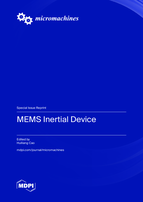MEMS Inertial Device
A special issue of Micromachines (ISSN 2072-666X). This special issue belongs to the section "E:Engineering and Technology".
Deadline for manuscript submissions: closed (31 July 2023) | Viewed by 13209
Special Issue Editor
Interests: MEMS; gyroscope; extreme environment sensing technology
Special Issues, Collections and Topics in MDPI journals
Special Issue Information
Dear Colleagues,
MEMS inertial devices are the most widely used component of MEMS sensors, including MEMS gyroscopes and MEMS accelerometers. It has the advantages of a small size, light weight, low cost, mass production and good impact resistance. It has important application value and broad application prospects in the national economy, national defense and military fields. The development of the current information intelligent era has brought new development opportunities for MEMS inertial devices, so that MEMS inertial devices have entered a new development stage of higher accuracy and higher reliability. Accordingly, this Special Issue seeks to showcase research papers, short communications, and review articles that focus on (1) microstructure optimization design of MEMS inertial devices, (2) MEMS inertial device measurements and control systems, (3) MEMS inertial device manufacturing technology, (4) the integrated application of MEMS inertial devices.
We look forward to receiving your submissions!
Prof. Dr. Huiliang Cao
Guest Editor
Manuscript Submission Information
Manuscripts should be submitted online at www.mdpi.com by registering and logging in to this website. Once you are registered, click here to go to the submission form. Manuscripts can be submitted until the deadline. All submissions that pass pre-check are peer-reviewed. Accepted papers will be published continuously in the journal (as soon as accepted) and will be listed together on the special issue website. Research articles, review articles as well as short communications are invited. For planned papers, a title and short abstract (about 100 words) can be sent to the Editorial Office for announcement on this website.
Submitted manuscripts should not have been published previously, nor be under consideration for publication elsewhere (except conference proceedings papers). All manuscripts are thoroughly refereed through a single-blind peer-review process. A guide for authors and other relevant information for submission of manuscripts is available on the Instructions for Authors page. Micromachines is an international peer-reviewed open access monthly journal published by MDPI.
Please visit the Instructions for Authors page before submitting a manuscript. The Article Processing Charge (APC) for publication in this open access journal is 2600 CHF (Swiss Francs). Submitted papers should be well formatted and use good English. Authors may use MDPI's English editing service prior to publication or during author revisions.
Keywords
- MEMS inertial device
- MEMS inertial device controlling method
- inertial device signal processing
- MEMS inertial device modeling and simulation
- MEMS gyroscope
- MEMS accelerometer
Related Special Issue
- MEMS Inertial Device, 2nd Edition in Micromachines (3 articles)







